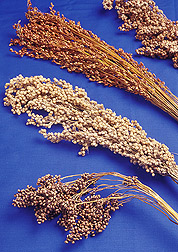Sorghum Collection Screening Reveals
New Sources of Anthracnose Resistance
|
|
At the ARS Tropical Agriculture Research Station, in Mayagüez, Puerto Rico, geneticist and sorghum curator John E. Erpelding has been screening sorghum germplasm for resistance to anthracnose. With roughly 43,000 accessions, the sorghum collection is one of the largest in the ARS-coordinated National Plant Germplasm System. Based in Griffin, Georgia, the ARS National Sorghum Germplasm Collection preserves genetic diversity from around the world, providing valuable sources of new genes for desirable traits, like disease resistance.
“Anthracnose” means “like coal,” because symptoms include small, oval, black lesions on the leaves. The fungus infects all aboveground parts of the plant, and in severe cases, the disease can kill plants before maturity. Often, anthracnose weakens the plant, severely reducing grain yield and quality. The United States produces about one-fifth of the world’s sorghum and is the leading exporter of grain sorghum.
Sorghum lines resistant to anthracnose exist, but the pathogen is highly variable.
“Through natural selection, disease pathogens can overcome plant resistance,” Erpelding says. “We’re screening samples to identify potential new sources of resistance.”
Since detailed evaluation data are lacking for more than half the sorghum collection, researchers have their hands full, unless they can find ways of predicting where resistance to diseases might be found.
Going to the Source
Since Africa is the center of origin for sorghum, Erpelding and Louis K. Prom, a plant pathologist in the ARS Crop Germplasm Research Unit, in College Station, Texas, started by screening collections from African countries. The first germplasm evaluated was from Sudan, considered a center of diversity for sorghum. They expected to identify resistance there—and did, in about half the lines they evaluated.
The next collection evaluated was from Mali, in West Africa. Considerably more accessions showed resistance—about 80 percent. Even though West Africa is considered a secondary center of diversity and anthracnose is prevalent there, the high number of resistant accessions was unexpected.
“This raised questions,” Erpelding says. “To provide answers, we selected subsets of germplasm that represent specific regions of Mali. One region in western Mali is dry in the north and wet in the south. When we evaluated the collection from this region, we saw an association between weather pattern and anthracnose resistance. More accessions from the dry area were susceptible, and more from the wet area were resistant. Nearly all the accessions from the wettest area were resistant.”
The variation in rainfall is not as extensive in other regions of Mali, but a similar pattern of resistance is present. Collections from other African nations were evaluated and similar results observed.
The work may enable breeders to pinpoint specific geographical sources of disease-resistant germplasm. Commercial seed-breeding companies have expressed interest in Erpelding’s findings.
Erpelding is working with ARS geneticist Robert R. Klein, who is mapping the sorghum genome. Klein is cloning important genes in regions of the genome that harbor key traits, such as anthracnose resistance.—By Jim Core, Agricultural Research Service Information Staff.
This research is part of Plant, Microbial, and Insect Genetic Resources, Genomics, and Genetic Improvement, an ARS National Program (#301) described on the World Wide Web at www.nps.ars.usda.gov.
John E. Erpelding is with the USDA-ARS Tropical Agriculture Research Station, 2200 P.A. Campos Ave., Suite 201, Mayagüez, PR 00680-5470; phone (787) 831-3435, fax (787) 831-3386.
"Sorghum Collection Screening Reveals New Sources of Anthracnose Resistance" was published in the February 2006 issue of Agricultural Research magazine.







